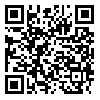Volume 11, Issue 1 (January & February 2020)
BCN 2020, 11(1): 79-90 |
Back to browse issues page
Download citation:
BibTeX | RIS | EndNote | Medlars | ProCite | Reference Manager | RefWorks
Send citation to:



BibTeX | RIS | EndNote | Medlars | ProCite | Reference Manager | RefWorks
Send citation to:
Hojjatinia S, Aliyari Shoorehdeli M, Fatahi Z, Hojjatinia Z, Haghparast A. Improving the Izhikevich Model Based on Rat Basolateral Amygdala and Hippocampus Neurons, and Recognizing Their Possible Firing Patterns. BCN 2020; 11 (1) :79-90
URL: http://bcn.iums.ac.ir/article-1-1393-en.html
URL: http://bcn.iums.ac.ir/article-1-1393-en.html
Sahar Hojjatinia1 
 , Mahdi Aliyari Shoorehdeli2
, Mahdi Aliyari Shoorehdeli2 
 , Zahra Fatahi3
, Zahra Fatahi3 
 , Zeinab Hojjatinia4
, Zeinab Hojjatinia4 
 , Abbas Haghparast *3
, Abbas Haghparast *3 


 , Mahdi Aliyari Shoorehdeli2
, Mahdi Aliyari Shoorehdeli2 
 , Zahra Fatahi3
, Zahra Fatahi3 
 , Zeinab Hojjatinia4
, Zeinab Hojjatinia4 
 , Abbas Haghparast *3
, Abbas Haghparast *3 

1- Department of Electrical Engineering and Computer Sciences, The Pennsylvania State University, Pennsylvania, USA.
2- Department of Electrical Engineering, K. N. Toosi University of Technology, Tehran, Iran.
3- Neuroscience Research Center, School of Medicine, Shahid Beheshti University of Medical Sciences, Tehran, Iran.
4- Department of Electrical Engineering, South Tehran Branch, Islamic Azad University, Tehran, Iran.
2- Department of Electrical Engineering, K. N. Toosi University of Technology, Tehran, Iran.
3- Neuroscience Research Center, School of Medicine, Shahid Beheshti University of Medical Sciences, Tehran, Iran.
4- Department of Electrical Engineering, South Tehran Branch, Islamic Azad University, Tehran, Iran.
Abstract:
Introduction: Identifying the potential firing patterns following different brain regions under normal and abnormal conditions increases our understanding of events at the level of neural interactions in the brain. Furthermore, it is important to be capable of modeling the potential neural activities to build precise artificial neural networks. The Izhikevich model is one of the simplest biologically-plausible models, i.e. capable of capturing most recognized firing patterns of neurons. This property makes the model efficient in simulating the large-scale networks of neurons. Improving the Izhikevich model for adapting with the neuronal activity of rat brain with great accuracy would make the model effective for future neural network implementations.
Methods: Data sampling from two brain regions, the HIP and BLA, was performed by the extracellular recordings of male Wistar rats, and spike sorting was conducted by Plexon offline sorter. Further analyses were performed through NeuroExplorer and MATLAB. To optimize the Izhikevich model parameters, a genetic algorithm was used. In this algorithm, optimization tools, like crossover and mutation, provide the basis for generating model parameters populations. The process of comparison in each iteration leads to the survival of better populations until achieving the optimum solution.
Results: In the present study, the possible firing patterns of the real single neurons of the HIP and BLA were identified. Additionally, an improved Izhikevich model was achieved. Accordingly, the real neuronal spiking pattern of these regions’ neurons and the corresponding cases of the Izhikevich neuron spiking pattern were adjusted with great accuracy.
Conclusion: This study was conducted to elevate our knowledge of neural interactions in different structures of the brain and accelerate the quality of future large-scale neural networks simulations, as well as reducing the modeling complexity. This aim was achievable by performing the improved Izhikevich model, and inserting only the plausible firing patterns and eliminating unrealistic ones.
Methods: Data sampling from two brain regions, the HIP and BLA, was performed by the extracellular recordings of male Wistar rats, and spike sorting was conducted by Plexon offline sorter. Further analyses were performed through NeuroExplorer and MATLAB. To optimize the Izhikevich model parameters, a genetic algorithm was used. In this algorithm, optimization tools, like crossover and mutation, provide the basis for generating model parameters populations. The process of comparison in each iteration leads to the survival of better populations until achieving the optimum solution.
Results: In the present study, the possible firing patterns of the real single neurons of the HIP and BLA were identified. Additionally, an improved Izhikevich model was achieved. Accordingly, the real neuronal spiking pattern of these regions’ neurons and the corresponding cases of the Izhikevich neuron spiking pattern were adjusted with great accuracy.
Conclusion: This study was conducted to elevate our knowledge of neural interactions in different structures of the brain and accelerate the quality of future large-scale neural networks simulations, as well as reducing the modeling complexity. This aim was achievable by performing the improved Izhikevich model, and inserting only the plausible firing patterns and eliminating unrealistic ones.
Keywords: Izhikevich model, Firing pattern, Optimization, Genetic algorithm, Basolateral amygdala, Hippocampus
Type of Study: Original |
Subject:
Computational Neuroscience
Received: 2018/12/29 | Accepted: 2019/12/2 | Published: 2020/01/10
Received: 2018/12/29 | Accepted: 2019/12/2 | Published: 2020/01/10
Send email to the article author
| Rights and permissions | |
 |
This work is licensed under a Creative Commons Attribution-NonCommercial 4.0 International License. |





